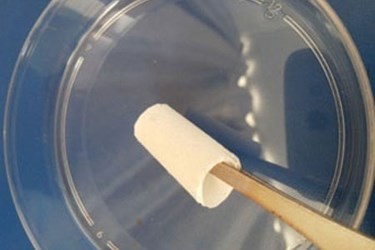Engineers Develop First Tri-Layer Artificial Blood Vessels

In a new advance in artificial blood vessels, Chinese scientists have developed a tri-layered composite using micro-imprinting and electrospinning techniques. By using three separate materials in their design, scientists hope to promote new cell growth on the surface of the vessel while maintaining its structural integrity.
To correct problems that result from obstructed vessels, surgeons attach grafts that redirect blood around the blockages. Traditionally, vascular grafts have been crafted from a patient’s own blood vessels or those from a matching donor. While this method minimizes risk of tissue rejection, it is not always feasible due to an insufficient supply of healthy vessels. In recent years, vascular graft research has turned its attentions toward biocompatible synthetic options.
According to research from Shanghai University’s Rapid Manufacturing Engineer Center (RMEC) that was published in AIP Advances, “The main challenge in tissue engineering is to fabricate customizable and biodegradable scaffolds that mimic the components and structural aspects of native extracellular matrices.”
The RMEC team, led by associate professor Yuanyuan Liu, found that electrospinning, a process which uses an electrical charge to extract nanofibers from liquid, was an effective technique to mimic blood vessel structure.
Using an electrospun mixture of chitosan and polyvinyl alcohol, Liu’s team designed a scaffold to which growing cells could adhere, but they worried the structure would not be strong enough to survive inside the body. To compensate, they added a middle layer of microprinted poly-p-dioxanone, a biodegradable polymer, to add mechanical strength. The ends of the tri-layered sheet were attached to form the vessel, researchers explained in a press release issued by the American Institute of Physics (AIP).
The researchers projected that the artificial vessel would dissolve within six months to a year after implantation, leaving behind a new blood vessel.
“The composite vascular grafts could be better candidates for blood vessel repairs,” said Liu in the AIP press release.
Liu also stated that her team planned to pursue further research with the artificial vessel in animal models with hopes of advancing to human clinical trials.
The most common type of vascular grafting in the United States is coronary artery bypass grafting (CABG). According to the University of Michigan Medical Center, surgeons in the U.S. perform over 500,000 of these procedures per year.
The CDC reports that cardiovascular disease accounts for 600,000 American deaths each year, and over half of these mortalities are due to coronary heart disease.
Image credit: Yuanyuan Liu/Shanghai University
